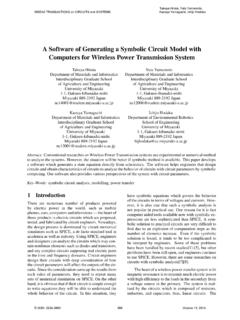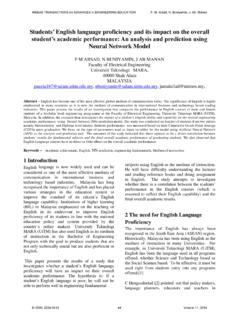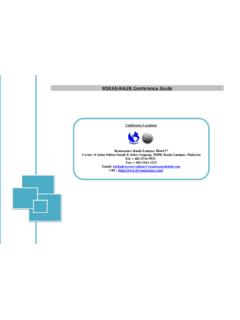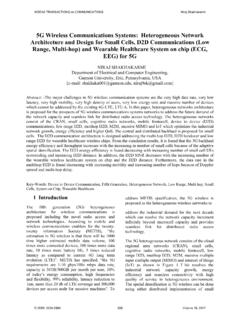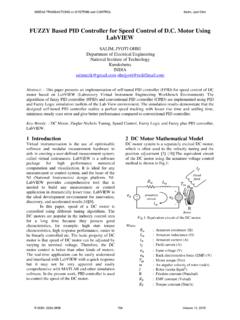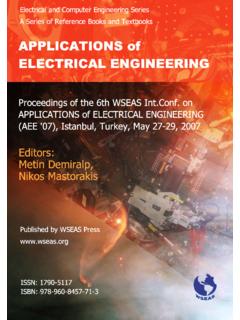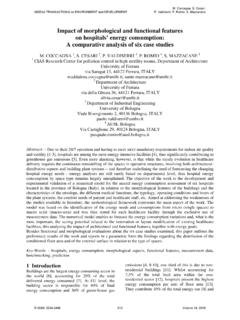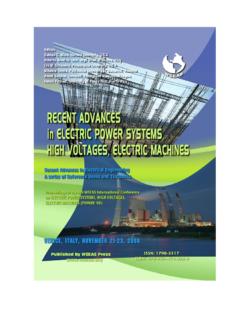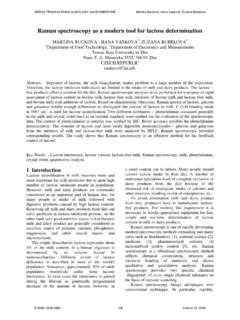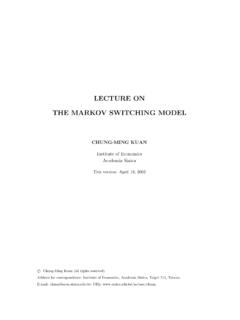Transcription of MATHEMATICAL METHODS in SCIENCE - wseas.org
1 MATHEMATICAL METHODS in SCIENCE and MECHANICS Proceedings of the 16th International Conference on MATHEMATICAL METHODS , Computational Techniques and Intelligent Systems (MAMECTIS '14) Proceedings of the 5th International Conference on Theoretical and Applied Mechanics (TAM '14) Lisbon, Portugal October 30 - November 1, 2014 Mathematics and Computers in SCIENCE and Engineering Series | 33 ISSN: 2227-4588 ISBN: 978-960-474-396-4 MATHEMATICAL METHODS in SCIENCE and MECHANICS Proceedings of the 16th International Conference on MATHEMATICAL METHODS , Computational Techniques and Intelligent Systems (MAMECTIS '14) Proceedings of the 5th International Conference on Theoretical and Applied Mechanics (TAM '14) Lisbon, Portugal October 30 - November 1, 2014 Published by WSEAS Press Copyright 2014, by WSEAS Press All the copyright of the present book belongs to the World Scientific and Engineering Academy and Society Press.
2 All rights reserved. No part of this publication may be reproduced, stored in a retrieval system, or transmitted in any form or by any means, electronic, mechanical, photocopying, recording, or otherwise, without the prior written permission of the Editor of World Scientific and Engineering Academy and Society Press. All papers of the present volume were peer reviewed by no less that two independent reviewers. Acceptance was granted when both reviewers' recommendations were positive. ISSN: 2227-4588 ISBN: 978-960-474-396-4 MATHEMATICAL METHODS in SCIENCE and MECHANICS Proceedings of the 16th International Conference on MATHEMATICAL METHODS , Computational Techniques and Intelligent Systems (MAMECTIS '14) Proceedings of the 5th International Conference on Theoretical and Applied Mechanics (TAM '14) Lisbon, Portugal October 30 - November 1, 2014 Editors: Prof.
3 Nikos E. Mastorakis, Technical University of Sofia, Bulgaria Prof. Francesco Mainardi, University of Bologna & INFN, Italy Prof. Mariofanna Milanova, University of Arkansas at Little Rock, USA Committee Members-Reviewers: Anca Croitoru Sk. Sarif Hassan Gabriela Mircea Isaac Yeboah Dana Anderson Elena Scutelnicu Daniela Litan Ibrahim Canak Vasile Cojocaru Hamideh Eskandari Claudia-Georgeta Carstea Elena Zaitseva Mihai Tiberiu Lates Yixin Bao Gabriella Bognar Muhammet Koksal Md. Shamim Akhter Vassos Vassiliou Yuqing Zhou Maria Dobritoiu U. C. Jha Bhagwati Prasad Emmanuel Lopez-Neri Carla Pinto Jose Manuel Mesa Fern ndez Zanariah Abdul Majid David Nicoleta Snezhana Georgieva Gocheva-Ilieva Al Emran Ismail Alina Adriana Minea Zengshi Chen Claudio Guarnaccia Konstantin Volkov Madalina Xenia Sorinel Oprisan Valeriy Perminov Chunwei, Lu Wini Lu Roots Larissa Jose Alberto Duarte Moller Hamed Ziaeipoor Guoxiang Liu Gilbert-Rainer Gillich M. M. Noor Natasa Trisovic Lu s Roseiro Diana Cotoros Elena Mereuta Ioana Adrian Alejandro Fuentes-Penna Mihaiela Iliescu Hanmin Jung Calbureanu Popescu Madalina Xenia Nikos Loukeris Rosli Abu Bakar Tiberiu Socaciu Mihaela Neamtu Lesley Farmer Monica Ciobanu Kandarpa Kumar Sarma Santhosh B Genqi Xu Noor Fadiya Mohd Noor Avijit Maji Naveen G.
4 Ramunigari Umer Asgher Gabriel Frumusanu Francesco Zirilli Xiaoguang Yue Ionu Porumbel Valeriu Dragan Zaharia Sebastian Zaini Ahmad Hugo Rodrigues Chao Wang Kai Xu Chiranth Srinivasan Ranjith Kannan Table of Contents Plenary Lecture 1: Human Action Recognition in Videos 10 Mariofanna Milanova Plenary Lecture 2: Topological METHODS for Higher Order Nonlinear Impulsive Boundary Value Problems 11 Feliz Minh s A Double Decomposition of the Test of Independence of Sets of Variables that Allows for a Modeling View of this Test 13 Carlos A. Coelho, Filipe J. Marques Autonomous Pareto Front Scanning using a Multi-Agent System for Multidisciplinary Optimization 20J. Martin, Georg , Gleizes, Mickael Meunier Equations and Integral Operators of Convolution Type on a Bounded Interval 30A. M. Simoes Portfolio Optimization in the Financial Market with Regime Switching under Constraints, Transaction Costs and Different Rates for Borrowing and Lending 38 Vladimir Dombrovskii, Tatyana Obedko An Application of Ordinary Differential Equations in Economics: Modeling Consumer s Preferences Using Marginal Rates of Substitution 46 Jorge Marques A New Inversion-Free Method for the Matrix Equation X + A*X^(- )A = I 54 Minghui Wang, Juntao Zhang On the Strong Consistency of Least Squares Estimates in Stochastic Regression Models with Associated Errors 58 Joao Lita Da Silva Some Properties on a Certain Class of Hurwitz Zeta Function Related to Linear Operator 65F.
5 Ghanim On Existence of Solutions for Nonconvex Optimal Control Problems 70 Clara Carlota, Silvia Cha Chord-Distance Signature Derivatives and Histogram of Oriented Gradient Features for Human Action Recognition 73 Salim Al-Ali, Mariofanna Milanova, Agata Manolova, Victoria Fox Failure Analysis of Off-Axis Crushing of Stitched Composite Absorbers 81H. Ghasemnejad, N. Ghafari-Namini, Z. Ravanpak MATHEMATICAL METHODS in SCIENCE and MechanicsISBN: 978-960-474-396-47 Parametric Simulation of Grounding Systems in the Frequency Domain using the Proper Generalized Decomposition 88J. Lazaro-Garcia, M. Pineda-Sanchez, D. Pareja-Perez, R. Puche-Panadero, A. Sapena-Ba o Quadruped Sensory-Driven Locomotion 92 Cesar Ferreira, Cristina P. Santos, J. G. Rocha Fundamental Solutions of Lame s Equations for Granular Media 98 Leonid Rozin, Elizaveta Zdanchuk On the Control of the Geophysical System: Problem Formulation 102 Sergei Soldatenko, Rafael Yusupov Simulation of Grounding Systems under Transient Conditions using the Proper Generalized Decomposition 107J.
6 Lazaro-Garcia, , D. Pareja-Perez, R. Puche-Panadero, J. Perez-Cruz, J. Martinez-Roman Calculus with Indiscernibility 113 Jos Roquette Bayesian and Neural Networks for Customer Satisfaction Optimization 119 Bozidar Klicek, Dijana Oreski, Sanja Oreski A Comparison of Lee-Carter and Cairns-Blake-Dowd Stochastic Mortality Model 130J n Gogola Toward an Efficient Implementation of Boosting Cascaded Classifiers for Face Detection 135 Nidal F. Shilbayeh, Khadija M. Al-Noori, Asim Alshiekh Face Recognition using Singular Value Decomposition and Hidden Markov Models 144 Petya Dinkova, Petia Georgieva, Mariofanna Milanova Community Detecting in Signed Networks based on Modularity 150 Rong-Rong Xue, Ying-Hong Ma, Wei Li Supersonic Boundary Layer Stability at Mass Transfer through a Wall 157S. A. Gaponov, N. M. Terekhova Experimental Investigation of Weapon System Mounted on Track Vehicle 166 Jiri Balla, Zbynek Krist, Cong Ich Le Quality Control Charts Using Different Ranked Set Sampling Schemes 173 Mohammad Al-Rawwash, Amjad D.
7 Al-Nasser, Amer I. Al-Omari A New Text Categorization (TC) Algorithm for Classifying Arabic Language Text Document 178 Khaled Alhawiti, Nidal F. Shilbayeh MATHEMATICAL METHODS in SCIENCE and MechanicsISBN: 978-960-474-396-48 MATHEMATICAL Modelling for the Solution of Incompressible Flow through Channels using Block Structured Grids 188 Christina G. Georgantopoulou, George A. Georgantopoulos, Nikolaos S. Vasilikos Solving Fuzzy VRP with Evolutionary Multi-Objective Algorithms 199 Seyed Mahmood Hashemi, Nikos Mastorakis Data Mining Techniques for Medical Applications: A Survey 205 Ibrahim M. El-Hasnony, Hazem M. El Bakry, Ahmed A. Saleh Two Markov Models in Formal Verification of Design Robustness 213S. Frenkel Simplified Particle Swarm Optimization Clustering Algorithm Based on P System 218 Yuyan Zheng, Yang Zhou, Jianhua Qu On Completely Controllable Pairs of Matrices 227 Gloria Cravo Efficiency Random Walks Algorithms for Solving BVP of Meta Elliptic Equations 232 Vitaliy Lukinov On Some Paracompactness-Type Properties of Fuzzy Topological Spaces 238 Francisco Gallego Lupi ez Authors Index 242 MATHEMATICAL METHODS in SCIENCE and MechanicsISBN: 978-960-474-396-49 Plenary Lecture 1 Human Action Recognition in Videos Professor Mariofanna Milanova Computer SCIENCE Department University of Arkansas at Little Rock USA E-mail: Abstract: Human action recognition in videos is a prominent field in multimedia research with numerous fundamental applications, including video surveillance, patient monitoring systems, law enforcement, video indexing and human computer interface.
8 While various algorithms have been developed for human action recognition the topic still remains a great challenge. There are infinite variations that can result from the combination of the various factors including the subject s body shape, motion, intention, surrounding environment and the dynamic context. Typical scenarios include scenes with cluttered, moving backgrounds, non-stationary camera, scale variations, changes in light and view points, etc. In this talk, novel algorithms for human action recognition are presented. The new algorithms are based on different types of features, such as for example contour-based features or silhouette-based features. For the classification step, experiments are obtained using support vector machine (SVM), K-mean and structure similarity measurement. Public data sets are illustrated and recognition methodologies performance are evaluated and compared.
9 The obtained results demonstrate a promising solution for improved accuracy and efficiency. Brief Biography of the Speaker: Mariofanna Milanova is a Professor of Computer SCIENCE Department at the University of Arkansas at Little Rock since 2001. She received a in Expert Systems and Artificial Intelligence in 1991. She obtained a in Computer SCIENCE in 1995 from the Technical University, Sofia, Bulgaria. Dr. Milanova conducted post-doctoral research in visual perception at the University of Paderborn, Germany. Dr. Milanova has extensive academic experience at various academic and research organizations worldwide. Dr. Milanova serves as a book editor for two books and as associate editor for various international journals. Her main research interests are in the areas of artificial intelligence, computer vision and communications, machine learning, privacy and security based on biometric research. She has published and co-authored more than 80 publications, over 53 journal papers, 11 book chapters, numerous conference papers and has 2 patents.
10 MATHEMATICAL METHODS in SCIENCE and MechanicsISBN: 978-960-474-396-410 Plenary Lecture 2 Topological METHODS for Higher Order Nonlinear Impulsive Boundary Value Problems Professor Feliz Minh s Departament of Mathematics University of vora Portugal E-mail: Abstract: The theory of impulsive problems is well adapted to study real phenomena where sudden changes occur at certain moments. Several examples arise naturally, not only on a micro scale but also on a global level, in physics, medicine, biotechnology, economics, control theory, population and/or gene dynamics,..This theory has become an increasingly important field in in research and it has been combined with different METHODS , boundary conditions and several interpretations for the impulse conditions. This presentation will include two types of boundary and impulsive conditions: A fourth-order periodic impulsive problem with a fully differential equation, that is, where the nonlinearity can depend in every derivatives till the third order, and the impulsive effects, are given by general functions, not necessarily linear.
